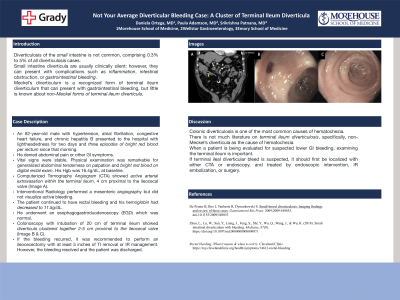Monday Poster Session
Category: GI Bleeding
P2530 - Not Your Average Diverticular Bleeding Case: A Cluster of Terminal Ileum Diverticula
Monday, October 28, 2024
10:30 AM - 4:00 PM ET
Location: Exhibit Hall E

Has Audio
- DO
Daniela Ortega, MD
Morehouse School of Medicine
Atlanta, GA
Presenting Author(s)
Daniela Ortega, MD1, Srikrishna Patnana, MBBS2, Paula Adamson, MD3
1Morehouse School of Medicine, Atlanta, GA; 2Emory University, Atlanta, GA; 3Wellstar Health System - Cobb Medical Center, Atlanta, GA
Introduction: Diverticulosis of the small intestine is not common, comprising 0.3% to 5% of all diverticulosis cases. Small intestine diverticula are usually clinically silent; however, they can present with complications such as inflammation, intestinal obstruction, or gastrointestinal bleeding. Meckel’s diverticulum is a recognized form of terminal ileum diverticulum that can present with gastrointestinal bleeding, but little is known about non-Meckel forms of terminal ileum diverticula.
Case Description/Methods: An 82-year-old male with hypertension, atrial fibrillation, congestive heart failure, and chronic hepatitis B presented to the hospital with lightheadedness for two days and three episodes of bright red blood per rectum since that morning. He denied abdominal pain or other GI symptoms. Vital signs were stable. Physical examination was remarkable for generalized abdominal tenderness on palpation and bright red blood on digital rectal exam. His Hgb was 16.4g/dL, at baseline. Computerized Tomography Angiogram (CTA) showed active arterial extravasation within the terminal ileum, 4 cm proximal to the ileocecal valve (Image A). Interventional Radiology performed a mesenteric angiography but did not visualize active bleeding. The patient continued to have rectal bleeding and his hemoglobin had decreased to 11.5g/dL. He underwent an esophagogastroduodenoscopy (EGD) which was normal. Colonoscopy with intubation of 20 cm of terminal ileum showed diverticula clustered together 2-5 cm proximal to the ileocecal valve (Image B & C). If the bleeding recurred, it was recommended to perform an ileocecectomy with at least 5 inches of TI removal or IR management. However, the bleeding resolved and the patient was discharged.
Discussion: Colonic diverticulosis is one of the most common causes of hematochezia. However, there is not much literature on terminal ileum diverticulosis, specifically, non-Meckel’s diverticula as the cause of hematochezia. When a patient is being evaluated for suspected lower GI bleeding, examining the terminal ileum is important. If terminal ileal diverticular bleed is suspected, it should first be localized with either CTA or endoscopy, and treated by endoscopic intervention, IR embolization, or surgery.

Disclosures:
Daniela Ortega, MD1, Srikrishna Patnana, MBBS2, Paula Adamson, MD3. P2530 - Not Your Average Diverticular Bleeding Case: A Cluster of Terminal Ileum Diverticula, ACG 2024 Annual Scientific Meeting Abstracts. Philadelphia, PA: American College of Gastroenterology.
1Morehouse School of Medicine, Atlanta, GA; 2Emory University, Atlanta, GA; 3Wellstar Health System - Cobb Medical Center, Atlanta, GA
Introduction: Diverticulosis of the small intestine is not common, comprising 0.3% to 5% of all diverticulosis cases. Small intestine diverticula are usually clinically silent; however, they can present with complications such as inflammation, intestinal obstruction, or gastrointestinal bleeding. Meckel’s diverticulum is a recognized form of terminal ileum diverticulum that can present with gastrointestinal bleeding, but little is known about non-Meckel forms of terminal ileum diverticula.
Case Description/Methods: An 82-year-old male with hypertension, atrial fibrillation, congestive heart failure, and chronic hepatitis B presented to the hospital with lightheadedness for two days and three episodes of bright red blood per rectum since that morning. He denied abdominal pain or other GI symptoms. Vital signs were stable. Physical examination was remarkable for generalized abdominal tenderness on palpation and bright red blood on digital rectal exam. His Hgb was 16.4g/dL, at baseline. Computerized Tomography Angiogram (CTA) showed active arterial extravasation within the terminal ileum, 4 cm proximal to the ileocecal valve (Image A). Interventional Radiology performed a mesenteric angiography but did not visualize active bleeding. The patient continued to have rectal bleeding and his hemoglobin had decreased to 11.5g/dL. He underwent an esophagogastroduodenoscopy (EGD) which was normal. Colonoscopy with intubation of 20 cm of terminal ileum showed diverticula clustered together 2-5 cm proximal to the ileocecal valve (Image B & C). If the bleeding recurred, it was recommended to perform an ileocecectomy with at least 5 inches of TI removal or IR management. However, the bleeding resolved and the patient was discharged.
Discussion: Colonic diverticulosis is one of the most common causes of hematochezia. However, there is not much literature on terminal ileum diverticulosis, specifically, non-Meckel’s diverticula as the cause of hematochezia. When a patient is being evaluated for suspected lower GI bleeding, examining the terminal ileum is important. If terminal ileal diverticular bleed is suspected, it should first be localized with either CTA or endoscopy, and treated by endoscopic intervention, IR embolization, or surgery.

Figure: Image A: Computerized Tomography Angiogram (CTA) showing active arterial extravasation within the terminal ileum.
Image B: Clustered terminal ileal diverticula.
Image C: Clustered terminal ileal diverticula.
Image B: Clustered terminal ileal diverticula.
Image C: Clustered terminal ileal diverticula.
Disclosures:
Daniela Ortega indicated no relevant financial relationships.
Srikrishna Patnana indicated no relevant financial relationships.
Paula Adamson indicated no relevant financial relationships.
Daniela Ortega, MD1, Srikrishna Patnana, MBBS2, Paula Adamson, MD3. P2530 - Not Your Average Diverticular Bleeding Case: A Cluster of Terminal Ileum Diverticula, ACG 2024 Annual Scientific Meeting Abstracts. Philadelphia, PA: American College of Gastroenterology.
